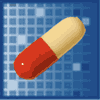News
Release 8.5 (October 2023)
Release 8.5 fixes a bug in the fitting of dose response curves in the GDSC2 dataset for 39 compounds where the concentration range differs between cell lines. IC50 values are highly correlated between releases 8.4 and 8.5 for the 14106 curves affected - a minimum Pearson correlation per compound of 0.888. Removing SN-38 from the dataset improves the minimum correlation to 0.995. The GDSC1 dataset remains unchanged from release 8.4.
Release 8.4 (July 2022)
The GDSC datasets have been updated with an additional 130612 IC50s. There are 36 previously unreleased compounds in the new GDSC1 dataset. The GDSC2 dataset now covers an extra 160 cell lines and 99 compounds, with 80% more IC50s than release 8.3.
- Total number of unique drugs
- 624
- Total number of IC50 values
- 576,758
- Total number of cell lines
- 978
Release 8.3 (June 2020)
The functionality of the Genomics of Drug Sensitivity in Cancer database has now been enhanced with two new data visualisations. The Combined Analyses Volcano Plot overlays all tissue specific and pan-cancer associations to visualize significant biomarker associations across all context-specific ANOVA analyses. Compare compound plots the correlation of dose response results (IC50 or AUC ) between different drugs across the cell line set.
Release 8.2 (Feb 2020)
This new release contains new drug sensitivity data for 70 compounds. These compounds add 60434 IC50 measurements across the GDSC1 and GDSC2 data-sets.
- Total number of unique drugs
- 518
- Total number of IC50 values
- 446,146
- Total number of cell lines
- 988
Release 8.1 (Oct 2019)
Following ongoing quality control of the GDSC data, some results were removed due to a failure of the experimental cell line sample to authenticate to a reference SNP profile. In particular, subsets of data have been removed from the GDSC1 dataset for RPMI-2650, while all results for NCI-H1395 have been removed from the GDSC1 and GDSC2 datasets.
- Total number of unique drugs
- 453
- Total number of IC50 values
- 385,712
- Total number of cell lines
- 988
Release 8.0 (Jul 2019)
The Genomics of Drug Sensitivity of Cancer (GDSC) database now contains data for an extra 187 drugs and more than 160,000 new unique compound cell-line pairs. This is an increase of ~70% compared to previous releases.
The website now has two datasets: GDSC1 and GDSC2. GDSC1 updates previous releases with additional drug screening data from the Wellcome Sanger Institute and Massachusetts General Hospital. Replicate data where available is now included in dose response fitting to improve IC50 estimates. 43,496 new IC50 results (compound cell-line pairs) have been added to previous datasets.
GDSC2 is new and has 118,595 IC50 results from the latest screening at the Wellcome Sanger Institute using improved experimental procedures (see Documentation - Screening).
Where screening has been replicated between GDSC1 and GDSC2 both results are available on the website. Our continuing effort to authenticate and annotate cell-lines ensures the quality of screening results - https://cellmodelpassports.sanger.ac.uk.
The homepage has been refreshed to enhance the user experience and the data download page has been revamped to improve access.
- Total number of unique drugs
- 453
- Total number of IC50 values
- 386,293
- Total number of cell lines
- 989
Release 7.0 (Mar 2018)
This release adds several new features and technical improvements
- Secure login environment for collaborators
- Improvements to data downloads
- Drug response data has been updated in line with internal quality control for drugs and cell lines.
In addition, the curve fitting code used by CancerRxGene.org has been released to GitHub at https://github.com/CancerRxGene/gdscIC50 and the raw data downloads have been made compatible with this package. This allows users to reproduce the results on this website or perform their own curve-fitting with different settings.
Release 6.1 (Mar 2017)
This release adds additional GDSC website functionality, minor bug fixes and updated drug annotations.
- Introduction of a new tab 'IC50 by tissue' on the compound page. This page facilitates cross-tissue comparison by splitting IC50 values by tissue type for each compound.
- Manual curation of the target and PUBCHEM annotation of compounds.
- Minor bug fixes in sorting compounds, display of search results and AUC and volcano plots.
Release 6 (July 2016)
Major upgrade
We are pleased to release a major upgrade to the GDSC website, including:
- New large-scale drug screening datasets
- New 'pan-cancer' and 'cancer-specific' analyses
- New website functionality to enable mining of datasets
- A bespoke data download tool
This release coincides with a publication in Cell from the GDSC team describing results from a new large-scale pharmacogenomic analysis. Data files supporting our publication can be found on the download page.
New data
- Total number of drugs
- 265
- Total number of IC50 values
- 224,510
- Total number of cell lines
- 1074
Release 5 (June 2014)
New cell line drug sensitivity page
Sensitivity data can now be browsed by cell line. The cell line page shows the sensitivity across all drugs for each cell line using a z-score value. The z-score describes whether a cell line is significantly sensitive or resistant to a drug compared to other cell lines screened against the same drug.
Further enhancements to IC50 scatter plots
Scatter plots of IC50 values now include a significance value (p-value) for each tissue type, thereby enhancing the ability to identify tissue specific gene-drug associations.
New data
- Total number of drugs
- 140
- Number of new IC50 values
- 6,734
- Total number of IC50 values
- 79,903
New Download files
We introduce new 'raw' and 'fitted' data files to the download page. These provide a simplified format for accessing drug sensitivity data. The 'raw' data file contains unprocessed fluorescence intensity values for all screening plates, and the 'fitted' data file provides a more complete description of drug response from our curve-fitting algorithm.
Release 4 (March 2013)
This release features improvements increasing the functionality of the GDSC website to facilitate analysis and interpretation of results.
Drug overview pages
These pages provide a visual summary of the screening results for each drug. Cell line IC50 values including confidence intervals are plotted as well as summary statistics for each drug. The overview page also contains separate plots for cell line IC90, IC75, IC25 and AUC (area under the curve) values for each drug.
IC50 scatter plots filtered by mutation and tissue type
The scatter plots of cell line IC50s values for significant drug-gene associations have been improved so that they can be filtered by mutation type (coding mutation, amplification or deletion) or by tissue type. A non-parametric test is performed for each resulting scatter plot to assess the significance of each association.
Important notice regarding change to data (16th January 2013)
We have identified a problem with 6349 IC50 values affecting multiple drugs from web release 3 (November 2012).
The source of the problem has been identified and resulted from an error introduced into the curve-fitting analysis pipeline during a recent code upgrade.
All affected data have been identified and will be removed from future datasets. While we correct this problem we are reverting the website to the data in web release 2 (July 2012).
We are introducing safeguards to prevent a similar error in the future.
We apologise for the inconvenience caused and thank you for your patience while we resolve this issue.
Release 3 (November 2012)
New data
This release sees the addition of 4,901 new IC50 values including data for 4 new anti-cancer drugs as well as new data for previously released compounds.
- Number of new drugs
- 4
- Total number of drugs
- 142
-
- Number of new IC50 values
- 4,901
- Total number of IC50 values
- 78,070
The therapeutic target(s) of drugs in this release are:
- PI3Kbeta (TXG221)
- IGF1R (GSK-1904529A)
- HDAC (LAQ824)
- PDPK1 (OSU-03012)
Enhanced cell line IC50 scatter plots
Cell lines are now coloured coded based on whether they have a coding mutation, amplification or homozygous deletion in a given cancer gene. This makes it simple to determine what types of mutations occur in a specific cancer gene and whether mutation-type influences drug response.
Release 2 (July 2012)
New data
This release sees the addition of 25,421 new IC50 values including data for 9 new anti-cancer drugs as well as new data for previously released compounds.
- Number of new drugs
- 9
- Total number of drugs
- 138
-
- Number of new IC50 values
- 25,421
- Total number of IC50 values
- 72,501
-
- Number of new cell lines
- 76
- Total number of cell lines
- 714
The therapeutic target(s) of drugs in this release are:
- PI3Kbeta (WO2009093972/AZD6482)
- BCL2-family members (TW-37)
- HSP90 (CCT018159)
- PARP1/2 (AG-014699)
- p70S6K (PF4708671)
- MDM2 (JNJ-26854165)
- gamma-secretase (BMS-708163)
- Rac GTPases (EHT 1864)
- PP1MD (CCT007093)
Drug sensitivity predictions with elastic net modeling.
We have enhanced the analysis of drug sensitivity data by including elastic net (EN) modeling. This approaches is able to scan across the genome to identify genomic, transcriptomic and tissue-type features associated with drug sensitivity or resistance. EN modeling results are presented as heatmaps and the results of this analysis are freely downloadable from the website.
EN modeling is available in addition to the multivariate ANOVA of drug sensitivity.
Scatter plots of IC50 values
This new functionality allows users to generate scatter plots of cell line IC50 values for significant drug-gene associations. Users are able to select which data to plot depending on their drug or gene of interest. Scatter plot images are downloadable and cell line IC50 values are directly linked to the COSMIC database facilitating integration of drug sensitivity data with detailed cell line information.
Release 1.1 (June 2012)
We have released an updated dataset to rectify a problem with 94 IC50 values. The drugs affected by this problem are ABT-263, AZD2281, BIBW2992, PLX4720, PD-173074 and PD-0325901.
Release 1 (March 2012)
We have launched a new website with enhanced user interfaces and released drug sensitivity data for 130 compounds across our cancer cell line collection.
New website
The new website allows improved access to cell line sensitivity data for anti-cancer drugs. Website features include the ability to search for genetic correlates of drug sensitivity or resistance by either compound name or specific cancer gene mutation. All drug sensitivity and genetic data are freely available and can be readily downloaded.
New drug sensitivity data
We have released cell line drug sensitivity data for 130 drugs representing >48,000 cell line-drug interactions. Drug sensitivity data have been correlated with mutations in cancer genes to identify genetic factors associated with drug sensitivity or resistance.
To receive news and release information, please sign up for the Translation-announce![]() mailing list.
mailing list.
Contact us | Cookies policy | Terms & Conditions. This site is hosted by the Wellcome Sanger Institute.



